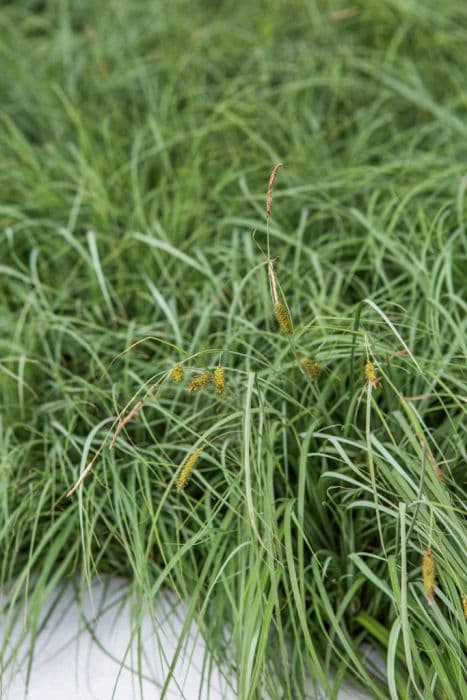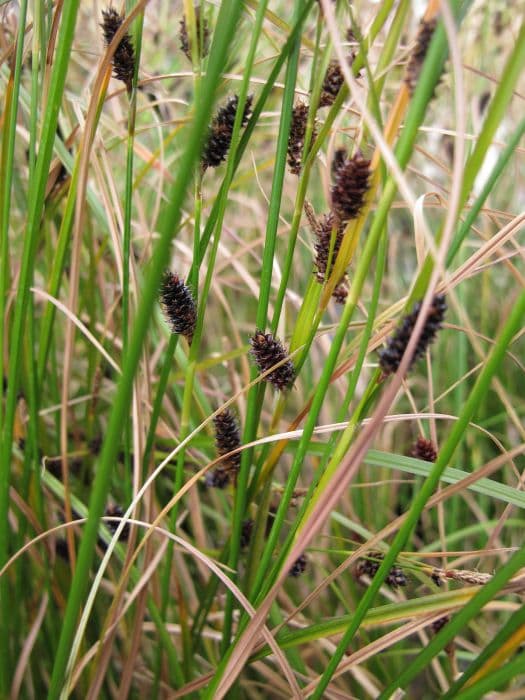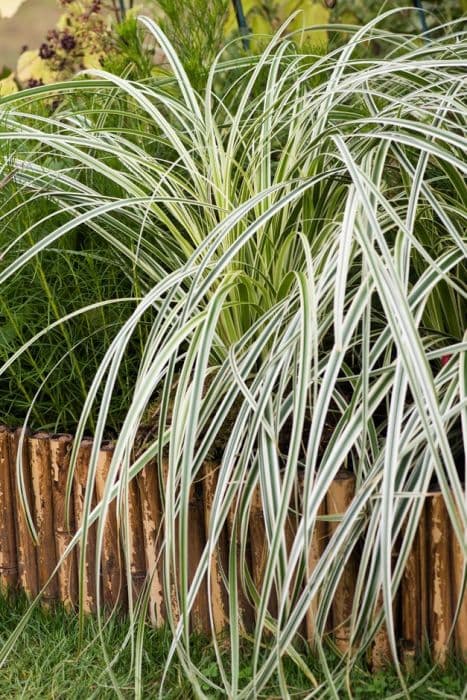Everillo Sedge Carex oshimensis 'Everillo' (PBR) (Evercolor Series)

ABOUT
Carex oshimensis 'Everillo', commonly known as sedge, is a striking ornamental grass with vibrant foliage. This cultivar is characterized by its eye-catching, brightly colored leaves. The leaves are narrow and arching, forming a mounded, tuft-like shape that adds texture and movement to garden spaces. Each leaf exhibits a luminous shade of yellow-green that can brighten up shaded areas or make a bold statement among other plants in a mixed border. Over time, the yellow hue may intensify, providing a dynamic shift in color as the seasons change. The foliage has a fine texture that lends an elegant touch to the plant's overall appearance. Though subtle, the sedge also produces small, brown flower spikes which add an extra but understated interest to its visual appeal. This plant is appreciated for its year-round color and easy-going nature, making it a low-maintenance choice for gardens and landscapes seeking a splash of enduring color.
About this plant
 Names
NamesFamily
Cyperaceae.
Synonyms
Everillo Sedge, Oshima Sedge, Evercolor Sedge, Golden Sedge.
Common names
Carex oshimensis 'Everillo' (PBR) (Evercolor Series).
 Toxicity
ToxicityTo humans
Sedge 'Everillo' is not known to be toxic to humans. Therefore, ingestion of this plant is not expected to cause poisoning or adverse health effects. Taking care when handling plants is still good practice to avoid potential skin irritation or allergic reactions, though specific symptoms of such reactions from this plant are not widely reported.
To pets
Sedge 'Everillo' is not considered toxic to pets. There should be no concerns about poisoning if your pet happens to ingest parts of this plant, as it doesn't contain any known toxic compounds that would harm pets like dogs or cats. As with any non-food plant material, ingestion can potentially cause mild gastrointestinal upset simply due to the digestion of unfamiliar matter, but no specific toxicity is associated with this plant.
 Characteristics
CharacteristicsLife cycle
Perennials
Foliage type
Evergreen
Color of leaves
Green
Height
1-2 feet (30-60 cm)
Spread
1-2 feet (30-60 cm)
Plant type
Grass
Hardiness zones
5-9
Native area
Japan
Benefits
 General Benefits
General Benefits- Low Maintenance: Requires minimal care once established, making it a good choice for gardeners of all experience levels.
- Year-Round Interest: Features vibrant yellow-green foliage that provides visual interest in the garden throughout the seasons.
- Shade Tolerance: Thrives in partially shaded areas where other plants may struggle.
- Drought Resistant: Once established, it can tolerate periods of dryness, reducing the need for frequent watering.
- Deer Resistant: Less likely to be eaten by deer, making it a suitable choice for gardens in areas with deer populations.
- Erosion Control: Its dense root system helps to stabilize soil and prevent erosion on slopes or banks.
- Color Contrast: The bright foliage contrasts well with darker plants, helping to add depth to garden designs.
- Border Planting: Compact and clump-forming, making it ideal for borders, edges, or as a groundcover.
- Cold Hardy: Can survive in colder climates, which expands its range of use in different garden zones.
- Non-Invasive: Unlike some other ornamental grasses, it does not aggressively spread and can be easily controlled.
 Medical Properties
Medical PropertiesThis plant is not used for medical purposes.
 Air-purifying Qualities
Air-purifying QualitiesThis plant is not specifically known for air purifying qualities.
 Other Uses
Other Uses- Crafts: The bright foliage of Everillo Sedge can be used in dried flower arrangements, adding a splash of color and unique texture.
- Photography: Due to its ornamental appearance, Everillo Sedge is often used as a subject or backdrop in plant photography.
- Theming gardens: This plant can be used in thematic garden designs such as 'moonlight' gardens due to its light-colored foliage that stands out in the twilight.
- Accentuating water features: Planting Everillo Sedge around ponds and streams can provide a contrasting color that highlights water elements in a landscape.
- Erosion control: Everillo Sedge's dense growth habit help with soil stabilization on slopes and banks.
- Fashion: The distinctive foliage can be incorporated into the design of eco-friendly fabrics or printed patterns for clothing.
- Bio-dye: The plant could potentially be used to create natural dyes for textiles, though this is more speculative and would require specific processing.
- Education: This plant serves as an educational tool in horticulture and botany courses, demonstrating plant variegation and care techniques for ornamental grasses.
- Eco-art: Everillo Sedge can be used in living sculptures or eco-art installations, integrating living plants into artistic designs.
- Habitat support: Although it's primarily ornamental, it can offer shelter for small garden fauna like insects and amphibians.
Interesting Facts
 Feng Shui
Feng ShuiThe Japanese Sedge 'Everillo' can be used in Feng Shui for its vibrant, evergreen foliage to introduce wood energy, promoting vitality and new growth, and it's bright, lightening presence can lift chi energy in darker spaces, ideally placed in the east for health or southeast for wealth.
 Zodiac Sign Compitability
Zodiac Sign CompitabilityThe Japanese Sedge 'Everillo' is not used in astrology practice.
 Plant Symbolism
Plant Symbolism- Vitality: Carex oshimensis 'Everillo', also known as Japanese Sedge, typically represents vitality due to its evergreen nature and year-round vibrancy, symbolizing life and enduring energy.
- Adaptability: Japanese Sedge thrives in a variety of conditions from shade to partial sunlight, symbolizing flexibility and the ability to adapt to different life circumstances.
- Balance: With its graceful, arching foliage that appears to be in perfect equilibrium, Japanese Sedge can represent balance, suggesting a harmonious and centered approach to life.
 Water
WaterThe Japanese Sedge 'Everillo' prefers consistently moist soil, so regular watering is crucial. During the growing season, water it thoroughly once or twice a week, depending on the weather conditions, ensuring that the soil doesn't dry out completely. Each watering session should provide enough water to moisten the soil to a depth of several inches. For potted plants, this might translate to about 16 to 32 ounces of water, depending on the size of the pot and the environmental conditions. During winter, reduce watering as the plant's growth slows down, but never let the soil become bone dry.
 Light
LightJapanese Sedge 'Everillo' thrives best in partial shade to full sun. The ideal location would receive bright, indirect sunlight for several hours a day while being protected from the harsh afternoon sun, which can scorch the leaves. An east or north-facing garden spot typically offers the perfect light conditions for this grass to flourish, providing it with a gentle mix of light and shelter.
 Temperature
TemperatureJapanese Sedge 'Everillo' is hardy and can tolerate a range of temperatures but thrives in conditions between 50°F to 75°F. While it can handle temperatures down to 20°F, prolonged exposure to temperatures below freezing can damage the foliage. It performs best and shows vibrant color when kept within its preferred temperature range.
 Pruning
PruningPruning Japanese Sedge 'Everillo' involves trimming back the foliage in late winter or early spring to remove any dead or damaged leaves and to maintain its tidy appearance. Prune up to a third of its height before it begins new growth to stimulate fresh, vibrant foliage. Pruning should be done annually, during a period when there is no risk of frost that could damage new growth.
 Cleaning
CleaningAs needed
 Soil
Soil'Everillo' Sedge thrives best in a soil mix that is well-draining and rich in organic matter. A combination of garden soil, peat moss, and perlite or sand would create an optimal environment. Aim for a slightly acidic to neutral pH, around 5.5 to 7.
 Repotting
RepottingEverillo Sedge does not require frequent repotting; it generally needs to be repotted every 2 to 3 years. It's important to refresh the soil and check if the plant has outgrown its current pot during the repotting process.
 Humidity & Misting
Humidity & MistingEverillo Sedge prefers moderate humidity levels but is relatively adaptable to various indoor environments. The best humidity range for this plant is between 40% and 70%.
 Suitable locations
Suitable locationsIndoor
Place Everillo Sedge in bright, indirect light and keep soil moist.
Outdoor
Plant in partial shade, moist soil, and protect from harsh sun.
Hardiness zone
5-9 USDA
 Life cycle
Life cycleThe life of Carex oshimensis 'Everillo', commonly known as Evercolor 'Everillo' Sedge, begins with germination from seed or more commonly from division, where a clump of sedge is separated into smaller sections that are then replanted. The plant then enters a phase of vegetative growth, thriving in part-shade to full sun conditions, establishing a dense, grass-like clump of brightly colored, arching foliage. As it matures, 'Everillo' produces small, inconspicuous flower spikes in late spring or early summer, though its primary ornamental value remains in its vibrant yellow-green foliage. After flowering, seeds may develop, which can be dispersed to encourage natural propagation. Throughout its life, which can be perennial in zones 5-9, it goes through seasonal cycles, with foliage remaining evergreen in milder climates or dying back in colder regions to re-emerge in spring. The plant will continue this cycle for many years, with division recommended every few years to maintain vigor and the bright coloration of the leaves.
 Propogation
PropogationPropogation time
Spring to Summer
Carex oshimensis 'Everillo', commonly known as Evercolor 'Everillo' Sedge, is predominantly propagated through division, which is a straightforward and effective method for this ornamental grass. The best time to divide Everillo Sedge is in spring, just as the plant is beginning to show new growth. This timing allows the divided plants to establish themselves during the growing season. To propagate by division, you would carefully lift the plant from the ground and use a sharp, clean knife or spade to slice through the root ball, ensuring that each section has a good amount of roots and shoots. After division, the sections can be immediately replanted in the ground or pots filled with well-draining soil, watered thoroughly, and kept moist until established. Generally, maintaining a distance of about 12 inches (approximately 30 centimeters) between each plant is recommended to give them enough room to grow.



![Japanese sedge [Everest]](/_next/image?url=https%3A%2F%2Fplants-admin.emdemapps.com%2Fimages%2Fplants%2F%2Fimages%2F604b5b6de0548.png&w=640&q=75)





